











Examples covering inheritance, collections, and exceptions.
Scientific experiments and many engineering tasks require performing measurements of physical quantities. Often, we will want to fit a model to the measurements. For example, consider the "hockey stick" graph of mean temperature change in the Northern hemisphere over the past millennium.
Many models of physical phenomenon are linear, or approximately linear:
One problem we face when trying to fit a model to the measurements is that physical measurements have limited precision; there will always be some deviation between the model and the measurements.
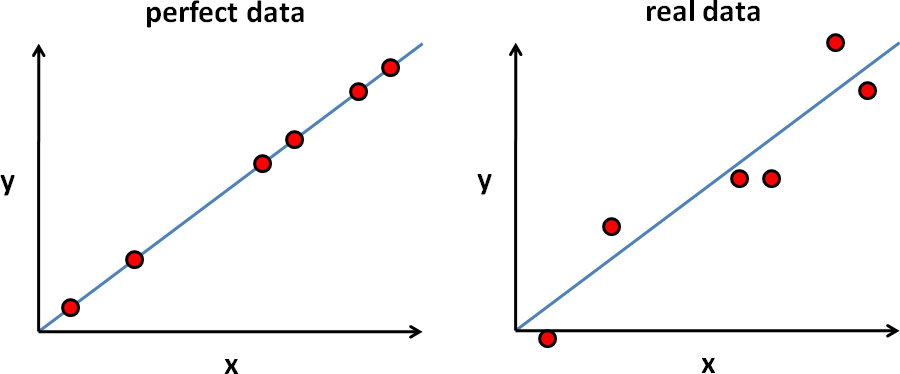
How do we fit a line to imperfect (noisy) data?
 Suppose we fit some line to the data and calculated the
vertical difference between the line and each data point. For
perfect data, these differences would all be zero. For real
data, these differences are not zero, and are a measure of
the goodness-of-fit between the line and data points.
The differences are called the residual errors.
Suppose we fit some line to the data and calculated the
vertical difference between the line and each data point. For
perfect data, these differences would all be zero. For real
data, these differences are not zero, and are a measure of
the goodness-of-fit between the line and data points.
The differences are called the residual errors.
In the figure on the left, the residual errors are labelled r0, r1, r2, r3, r4, r5.
The residual errors can be combined in a mathematical function to produce a function related to the quality of the fit of the line to the data. The most commonly used function is the sum of squared residual errors (Gauss), which in our example is:

In general, for n data points, the sum of squared residual errors is:
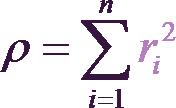
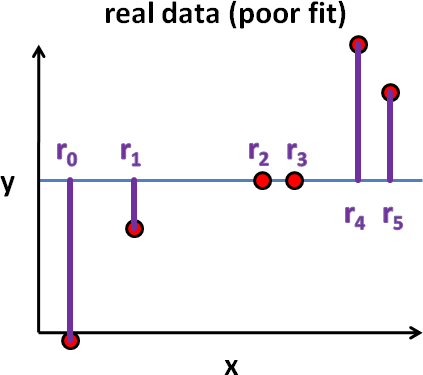 Suppose the fit between a line and the data points is
poor; then the function ρ will have a large value.
Conversely, if the the fit is good, the function
ρ will have a small value.
Suppose the fit between a line and the data points is
poor; then the function ρ will have a large value.
Conversely, if the the fit is good, the function
ρ will have a small value.
The line of best fit is the one that minimizes the function ρ.
Deriving the line of best fit is not difficult, but requires a second course in differential calculus or linear algebra.
First compute the following four quantities:
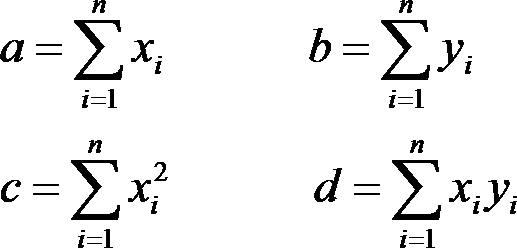
The slope of the best fit line is:
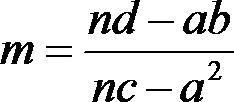
The y-intercept of the best fit line is:
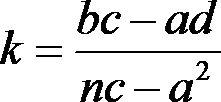
linedata1.txt contains perfect data from the
line with slope m = 1 and intercept k = 0.
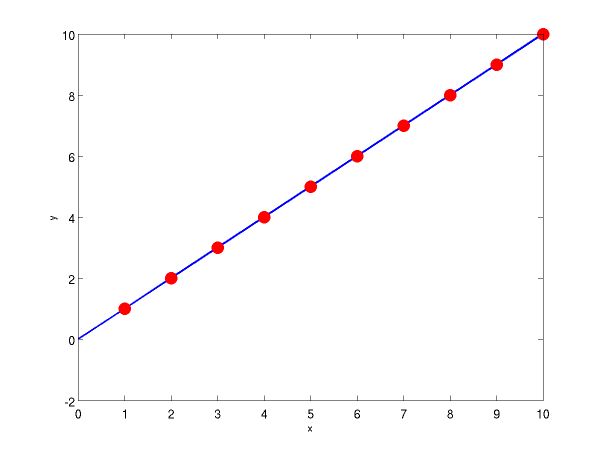
linedata2.txt contains noisy data from the
line with true slope m = 1 and true intercept k = 0.
MATLAB computes an estimated slope of m = 1.1433 and
estimated intercept of k = -0.7868.
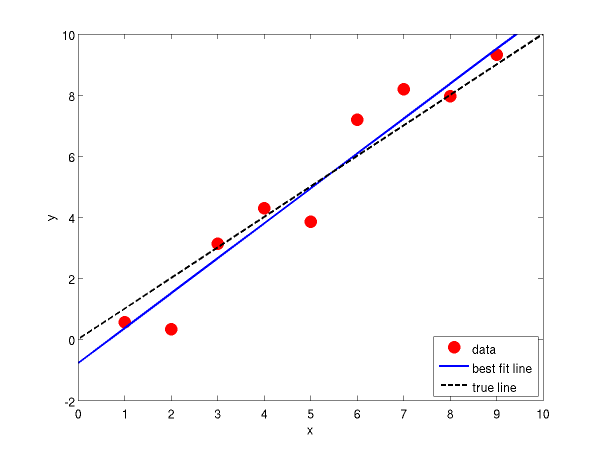
linedata3.txt contains noisy data from the
line with true slope m = 1 and true intercept k = 0.
There are data points with duplicate values of x.
MATLAB computes an estimated slope of m = 0.9391 and
estimated intercept of k = 0.5477.
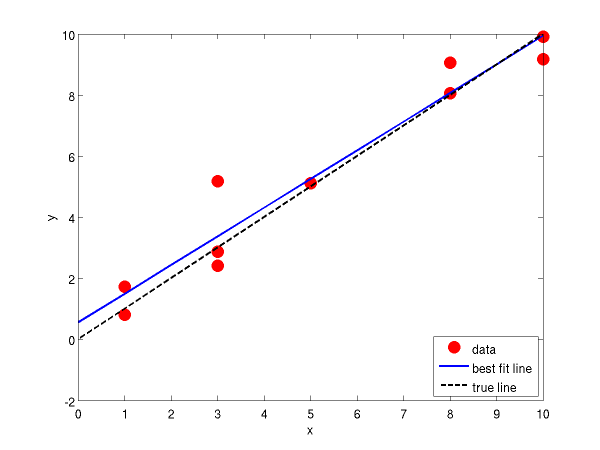
linedata1.txt
linedata2.txt
linedata3.txt
Because a Map is used to store the x and y coordinates, this
solution does not allow for duplicated x coordinates; thus, you
will get a different answer if you run this program using
linedata3.txt as input.
import java.io.*;
import java.util.*;
public class LineFit
{
public static void main(String[] args)
{
PrintStream output = System.out;
Scanner input = new Scanner(System.in);
// get the file name
output.print("Name of data file: ");
String fileName = input.next();
output.println();
Map<Double, Double> data = new HashMap<Double, Double>();
try
{
// read the data points into the map
Scanner fileInput = new Scanner(new File(fileName));
while (fileInput.hasNext())
{
double x = Double.parseDouble(fileInput.next());
double y = Double.parseDouble(fileInput.next());
data.put(x, y);
}
// must be at least 2 points
if (data.size() < 2)
{
throw new IllegalArgumentException("Not enough data points");
}
// compute a, b, c, d
double a = 0.0;
double b = 0.0;
double c = 0.0;
double d = 0.0;
for (Double x : data.keySet())
{
double y = data.get(x);
a += x;
b += y;
c += x * x;
d += x * y;
}
// compute slope m
int n = data.size();
double m = (n * d - a * b) / (n * c - a * a);
// compute slope
double k = (b * c - a * d) / (n * c - a * a);
// output
output.println("line of best fit:");
output.println("m = " + m);
output.println("k = " + k);
}
catch (FileNotFoundException ex)
{
output.printf("File named %s not found.%n", fileName);
}
catch (NumberFormatException ex)
{
output.println("Non-numeric data.");
}
}
}
This approach uses two Lists to store the x and y
coordinates which allows for duplicated x coordinates; thus, you
will get the Matlab answer if you run this program using
linedata3.txt as input.
import java.io.*;
import java.util.*;
public class LineFitList
{
public static void main(String[] args)
{
PrintStream output = System.out;
Scanner input = new Scanner(System.in);
// get the file name
output.print("Name of data file: ");
String fileName = input.next();
output.println();
List<Double> xData = new ArrayList<Double>();
List<Double> yData = new ArrayList<Double>();
try
{
// read the data points into the map
Scanner fileInput = new Scanner(new File(fileName));
while (fileInput.hasNext())
{
double x = Double.parseDouble(fileInput.next());
double y = Double.parseDouble(fileInput.next());
xData.add(x);
yData.add(y);
}
// must be at least 2 points
if (xData.size() < 2)
{
throw new IllegalArgumentException("Not enough data points");
}
// compute a, b, c, d
double a = 0.0;
double b = 0.0;
double c = 0.0;
double d = 0.0;
Iterator<Double> xIter = xData.iterator();
Iterator<Double> yIter = yData.iterator();
for (; xIter.hasNext();)
{
double x = xIter.next();
double y = yIter.next();
a += x;
b += y;
c += x * x;
d += x * y;
}
// compute slope m
int n = xData.size();
double m = (n * d - a * b) / (n * c - a * a);
// compute slope
double k = (b * c - a * d) / (n * c - a * a);
// output
output.println("line of best fit:");
output.println("m = " + m);
output.println("k = " + k);
}
catch (FileNotFoundException ex)
{
output.printf("File named %s not found.%n", fileName);
}
catch (NumberFormatException ex)
{
output.println("Non-numeric data.");
}
}
}